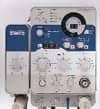Patient care and technology are top priority at Hoag Memorial Hospital Presbyterian in Newport Beach, Calif.

Staff at Hoag Memorial Hospital Presbyterian in Newport Beach, Calif, put out fires of a medical sort every day, but in late October 2003 they found themselves facing the real thing as brush fires raged near the Southern California coast. As smoke hung low over much of the region, respiratory therapists were ready for emergency care unit patients who needed treatment for exposure to dust and ash.
The acute care hospital handles 10 times as many outpatients as inpatients each year and offers a full range of health care services. The quality of its facilities and services has been recognized locally, where it is consistently voted best in consumer choice polls and newspaper surveys, and nationally in evaluations by healthcare industry organizations.“Because 50% of our catchment area is ocean communities, we must offer continuing excellence to draw in patients from a large region,” says Robert Braithwaite, vice president for operations. Hoag Hospital has four specialty centers, six freestanding health centers for primary and urgent care, and the Family Care Centers Medical Group, which comprises five facilities that are open 7 days per week. The hospital itself has grown to 409 beds, from 75 beds when it opened in 1952. The staff includes 925 doctors and 65 respiratory therapists.
Outreach and Education
The fact that Hoag Memorial Hospital Presbyterian is one of a few remaining nonprofit hospitals in the county presents distinct challenges as well as advantages in terms of healthcare delivery. “The hospital is driven not just by requirements or expectations but also by its commitment to serve the community, based upon patients’ needs rather than their ability to pay for healthcare,” explains Braithwaite.
The hospital funds a freestanding clinic a few miles away, where primary care is offered for the uninsured. Hoag also funds a program in which pulmonary department personnel visit local schools to teach students about asthma, and, through its affiliation with a community college, the department helps train respiratory care students. “We spend a lot of time and resources on outreach programs, as a basic component of our commitment to providing healthcare to the entire community,” says Braithwaite.
The respiratory therapists recently designed an educational conference entitled Advances in Respiratory Care 2003, a first for the pulmonary department and so well received (more than 100 RTs and nurses from Hoag and other area hospitals attended) that the department hopes to make it an annual event.
The respiratory therapists at Hoag Hospital play a vital role in the protocols of the medical-surgical and four critical care units, as well as the emergency care unit, to which one therapist is assigned each day. “The services of the respiratory therapists are some of the most essential in the hospital,” confirms Braithwaite, who adds that they “are woven into the fabric of patient care” at Hoag.
“Our pulmonary rehab program has been in operation for 28 years,” explains Michael Gonzales, RRT, director of the pulmonary department. “This service is a huge benefit for those with lung disease, to help them function at a better level. In addition, we offer inpatient and outpatient bronchoscopy, and our pulmonary lab stays quite busy with regular testing and specialized tests for asthma and lung disease.”
To ensure maximum flexibility among the respiratory care staff, therapists undergo cross-training in every area; thus, for example, a therapist might be as comfortable in an adult intensive care unit (ICU) as in the neonatal ICU. “We have a good combination of veterans, with more than 10 years of experience in the field, and new therapists with 1 or 2 years of experience,” notes Gonzales.
“It’s a great balance of experience and fresh enthusiasm,” says educational supervisor Kerman Rogers, BS, RRT. “And with our preceptor program, new therapists are paired with mentors who stay with them through each phase of orientation. This helps them build rapport and makes the transition into the department easier. We’ve used this strategy for about a year, and it has worked out well.”
Gonzales finds that a personal approach also helps with recruitment and retention. “We have developed a ladder by which each therapist can develop clinical skills and reach his or her full potential. Having a full-time medical director in the department is a huge asset, because he keeps us focused and is there to help out with quick questions on the floor. The respiratory therapists go on rounds with him every week.”

Latest Technology
Keeping up with the latest technology is a challenge for respiratory therapists at any facility, but at Hoag Hospital it is a priority. The hospital is committed to maintaining state-of-the-art technology in every department, not the least of which is respiratory care services. “We are typically the first in this region to use new technologies,” says Braithwaite, “and supporting each caregiving team is inherent in being a high-tech leader.” One downside of maintaining the hospital’s technological edge, he notes, is the need for constant training to deploy new technologies. For the pulmonary department, this is where Kerman Rogers comes in.
Rogers helps the RTs embrace new approaches and technological changes with needs-based training and in-services. “We are always evaluating new equipment and looking at how products that are new on the market actually work for our patients. We recently evaluated a new airway clearance device; it got a good response, and doctors seemed to like it.” The in-services are held monthly in the form of product presentations by manufacturers’ representatives or presentations of new advancements in therapy. These in-services also present opportunities for therapists to earn continuing education credits.
“The goal of the pulmonary department is to provide excellent service with compassion and good judgment,” explains Rogers. “We want to be responsive to the needs of the patients and maintain a positive and resourceful attitude.” Using good judgment in patients’ care involves making sure that services are being utilized properly, adds Gonzales. “We constantly evaluate patients’ therapy to determine whether it should be changed or stopped, and we discuss this with the physicians as part of the protocol. We make sure that what we are doing [for each patient] makes sense.”
The administration’s support of the respiratory therapy staff is reflected in its backing of the recent conference. “The idea came from a brainstorming session with respiratory therapists and corporate communications staff, who thought it might be a good tool for retention and a means of advancing the profession; we ran with it,” says Braithwaite. “We saw it as an opportunity not just to gain exposure for the services they offer at Hoag but also to send out a clear signal that we value them as [providers of] a core service. We didn’t want to be subtle about it.”
Great Place to Work
Although respiratory therapy programs at for-profit facilities may struggle (after all, Braithwaite says, “pulmonary rehab is not a cash cow”), Gonzales states that at Hoag Hospital, “we are given the resources we need to take care of the patients. If there is a clinical need for equipment, then we can get it. It’s a great place to work.”
But with that financial support comes financial responsibility, Gonzales notes, and that is one aspect of how the role of respiratory therapists has changed over the years. “We have to be good not only technically but also in our ability to assess therapy, so that we can be efficient and minimize waste. With each patient, we ask ourselves, ‘Is this therapy working, or do we need to try something else?’ ”
Rogers sees the huge success of the first respiratory care conference and the wide spectrum of topics discussed there as encouraging signs: “Respiratory therapists now recognize themselves as a part of a whole team caring for a patient.”
“Everyone has the opportunity to express their viewpoints,” adds Gonzales, “and together a general plan is made for the patient’s care. As team members, our input is highly regarded and can have an impact on outcome and length of stay.”
Seleen Street Collins is a contributing writer for RT.








